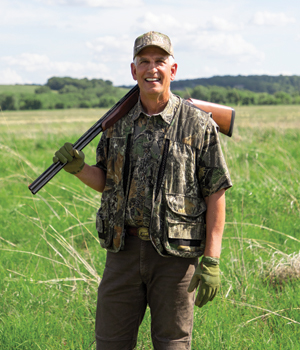Joe Wilkinson stopped hunting as a teenager, but he took it back up when he joined the Iowa Department of Natural Resources at age 30. Now it’s become a passion. Here he is with a bow in Solon near Lake Macbride State Park.
Writer and photographer: Emily Blobaum
In 2003, Jeff Vonk met with his colleague Ross Harrison to figure out ways to address Iowa’s out-of-control deer population. They had another goal, too: to help food-insecure Iowans. Vonk, then the director of the Iowa Department of Natural Resources, had just learned of a program in Pennsylvania allowing hunters to share extra venison with food pantries.
He thought they could do the same.

At that time, more than half a million white-tailed deer roamed the state, thanks in part to an abundance of food and mild weather conditions. But the deer population was growing at a faster rate than hunters could harvest them, causing widespread damage to agriculture and an increasing number of car collisions. Meanwhile, about 8% of Iowa’s population was food insecure.
So Vonk and Harrison devised a new program and called it HUSH, or Help Us Stop Hunger. It connected hunters with Iowa’s food banks, which would then donate venison to food pantries around the state. Since the program launched in 2003, hunters have donated 3.4 million pounds of venison, or more than 12.8 million meals, to Iowa food banks.
What’s more, the need has only grown: Right before the pandemic, 11% of Iowans were food insecure, according to Steve Laudick, vice president of business administration for the Food Bank of Iowa—up from the 8% figure in 2003. And in March 2021, a year after the pandemic started, Feeding America reported almost 13% of Iowans were food insecure.
“The HUSH program is very important,” Laudick says. “It supplements the other protein sources that we have. Even though we live in the heartland, we don’t really get a lot of beef, chicken or turkey.”
In 2020, hunters donated about 3,000 deer, or more than 120,000 pounds of venison. Any Iowa hunter who purchases a deer license can participate in HUSH. All they have to do is drop off a legally harvested deer to a participating meat locker and fill out a card. (Find the full list of lockers at iowadnr.gov.) Lockers get $75 per deer from the Food Bank of Iowa for participating.
Lockers process the meat and package ground venison into 2-pound tubes. From there, the meat goes to Iowa’s food banks, which then distribute it to pantries, meal sites and other providers. Agencies and pantries from all 99 counties can request the venison.
Milo Locker Meats, located southeast of Indianola, was one of Iowa’s 35 participating lockers in 2020 and has been one of the top HUSH deer processors. Co-owner Angela Goering says the locker received more than 300 deer, or just over 14,000 pounds of venison, in 2020 for the HUSH program.
“It’s a very important program, especially with the pandemic,” she says. “Families need that food. They need that ground venison.”
The program also allows “hunters to give back to the community,” she adds.

Hunters Who Help
Solon native Joe Wilkinson is one of those hunters. He began hunting with his dad when he was a kid, but stopped in his early teens. When he turned 30, he joined the Iowa DNR, which rekindled his interest in the sport.
“One of the questions they asked me [in my job interview] was, ‘You wouldn’t mind hunting, would you?’” says Wilkinson, who’s now retired. “I always have enjoyed hunting; I just got away from it.”
When he worked for the DNR as an information officer, he promoted HUSH to news outlets around the state. He’s also donated a few deer himself. “I believe in [the program],” he says. “You’re helping control the deer population, and you’re helping put venison on the table.”
Steve Dermand, who lives in Indianola and retired from the DNR’s law enforcement bureau in 2013, has participated in the program since its beginning in 2003. He hunts in five counties and harvests between 10 and 12 deer every year, donating several to HUSH.
“I’m in a single individual household and I butcher one or two deer for my own consumption, so the other deer I harvest need a place to go,” he says. “The HUSH program is a way to manage the population while also not letting deer go to waste.”
A Job Well Done
Since HUSH began, the state’s deer population has stabilized. Beginning in 2010, hunters statewide reported harvests between 100,000 and 120,000 deer per year, down from 150,000 in 2006.
HUSH’s peak year was in 2007, when more than 8,000 deer were donated statewide. Since then, the program has seen gradual declines in donations, leveling off to an average yearly donation of 3,500 deer. The number shows that HUSH has done its job in managing the deer population, says Alicia Plathe, HUSH coordinator.
However, without careful regulation, Iowa’s deer numbers could grow 20% to 40% each year. That, and the uptick in food insecurity, means HUSH is likely to continue.
“We still need to have hunting as a wildlife management tool,” Wilkinson says. “It’s a hunter’s duty to keep the population controlled, and if you can’t eat it all, give it to someone who needs it.”











